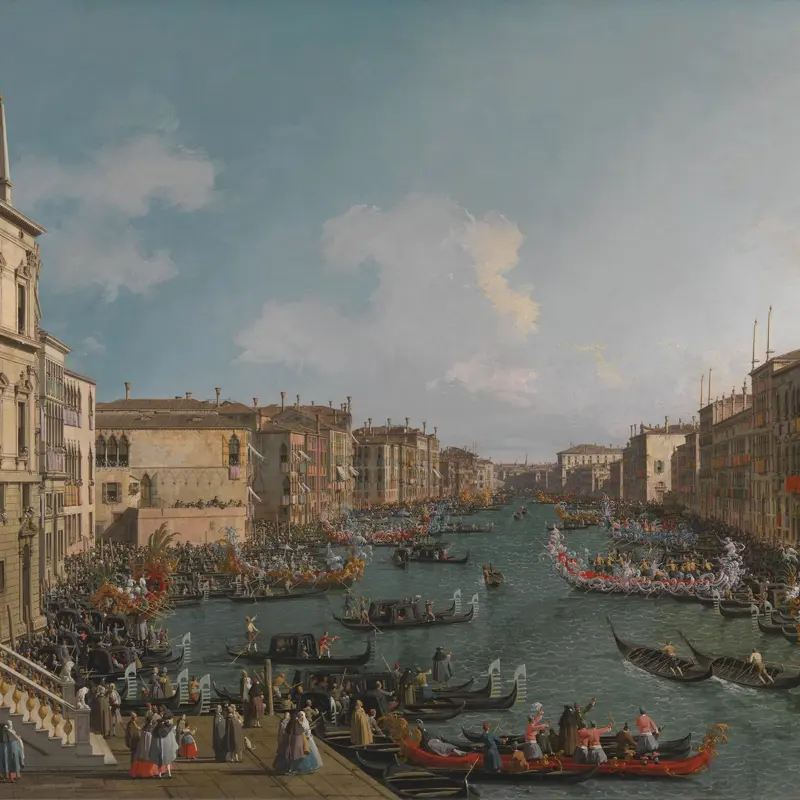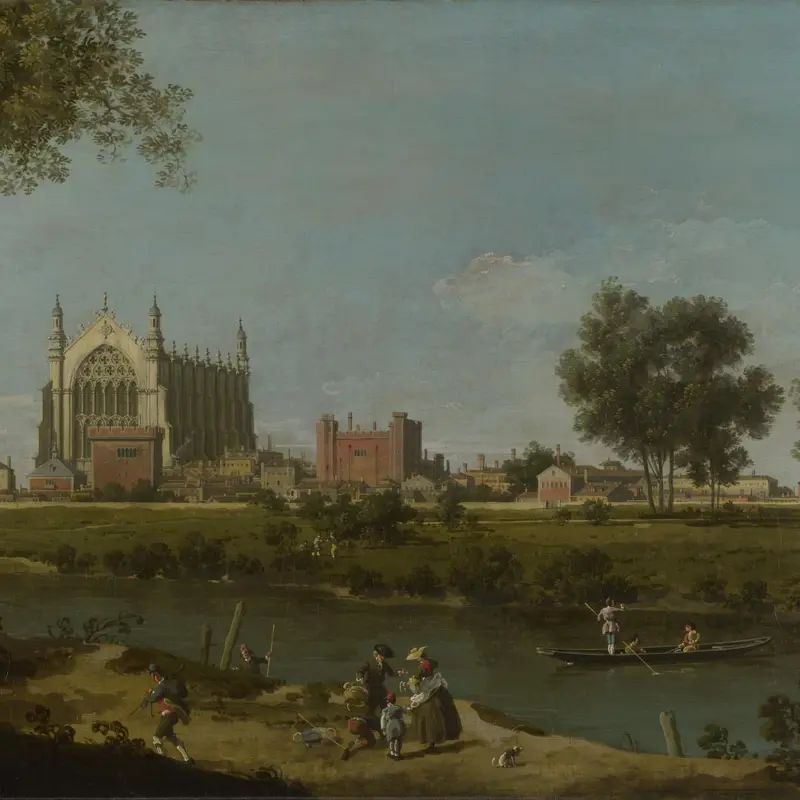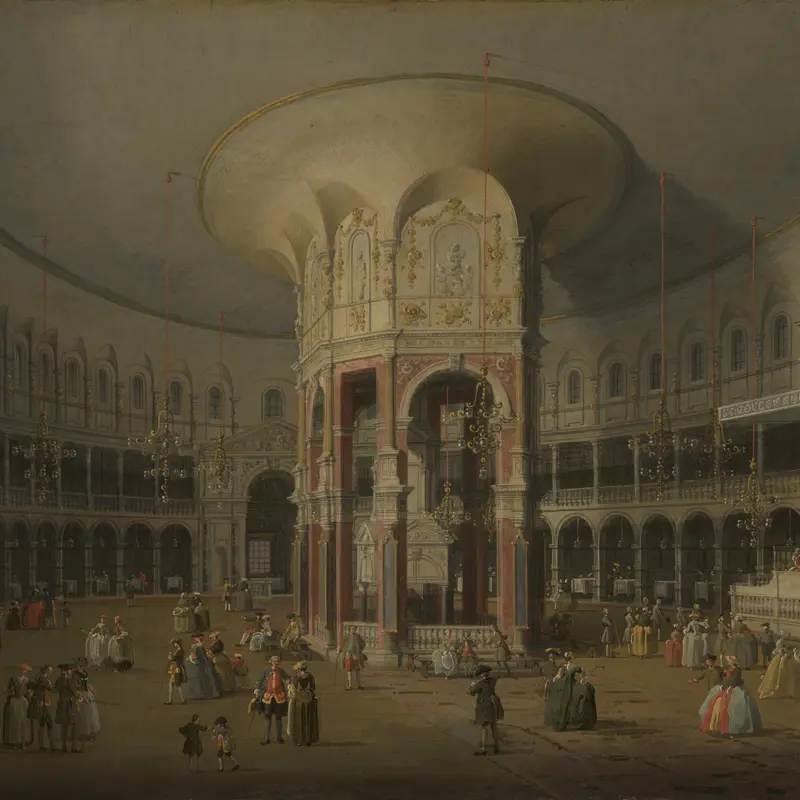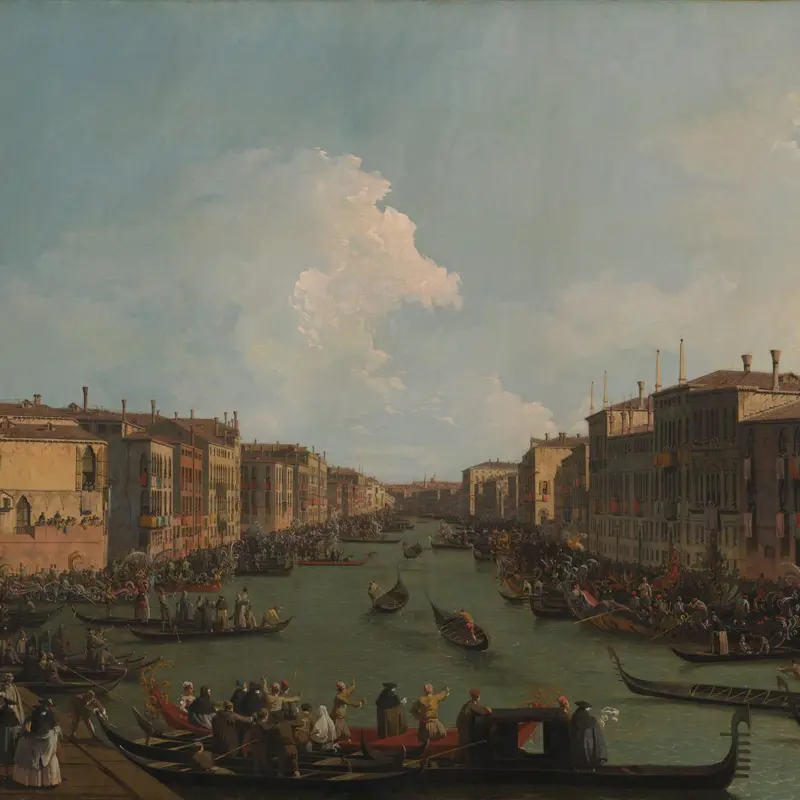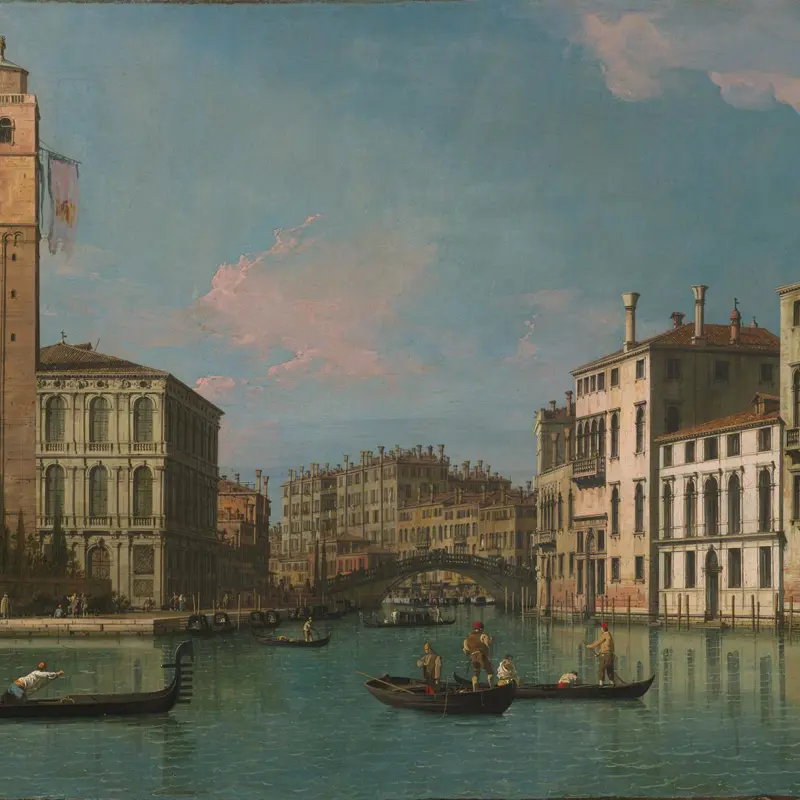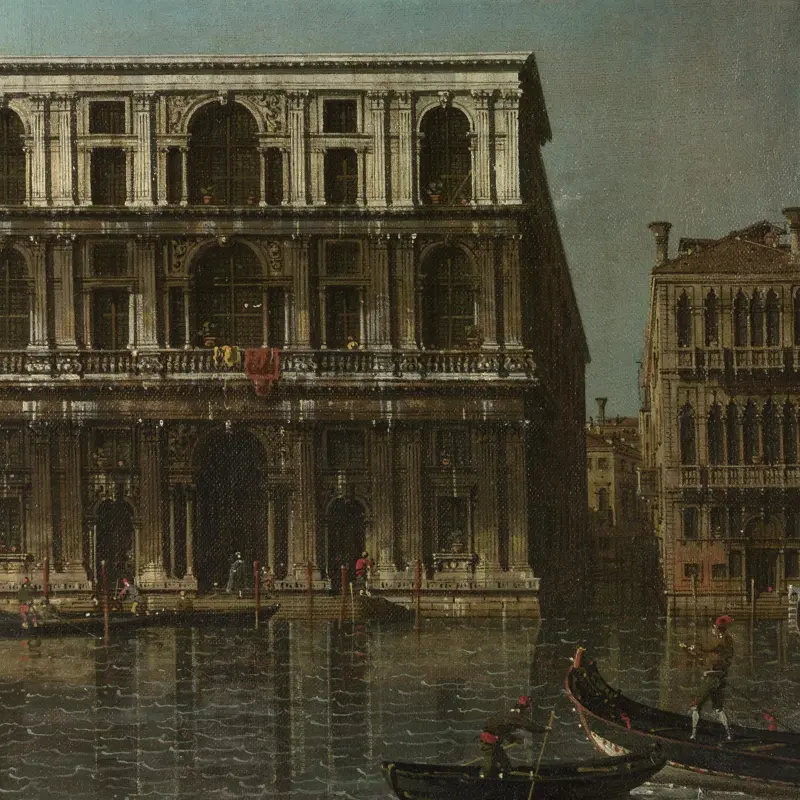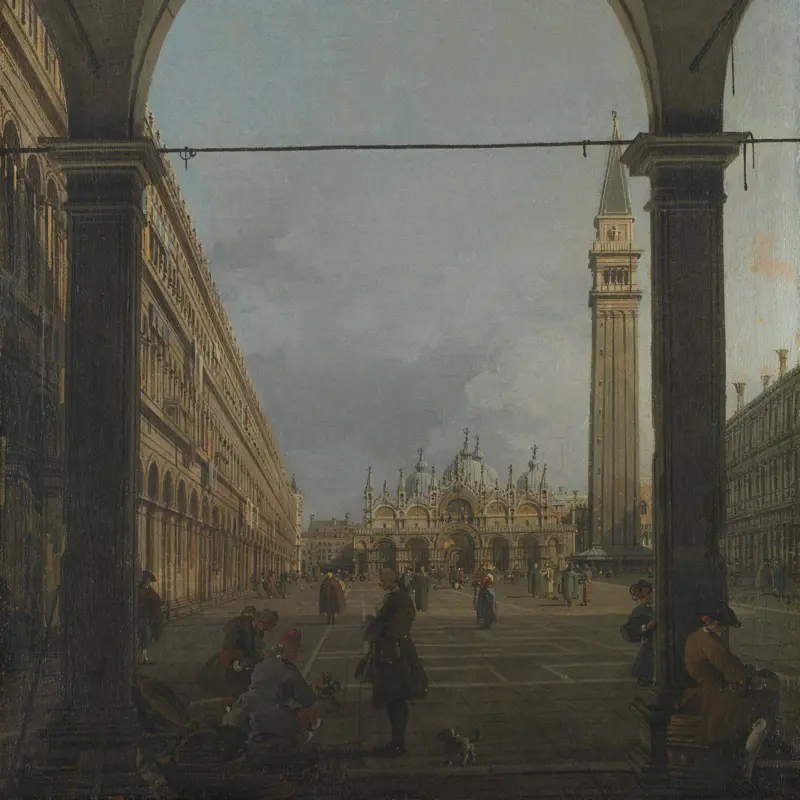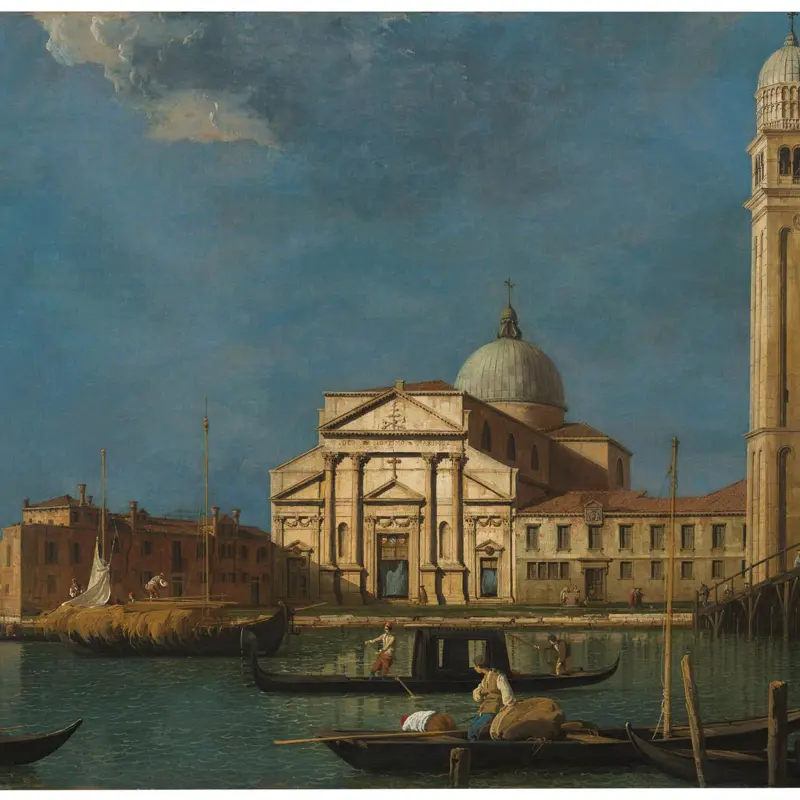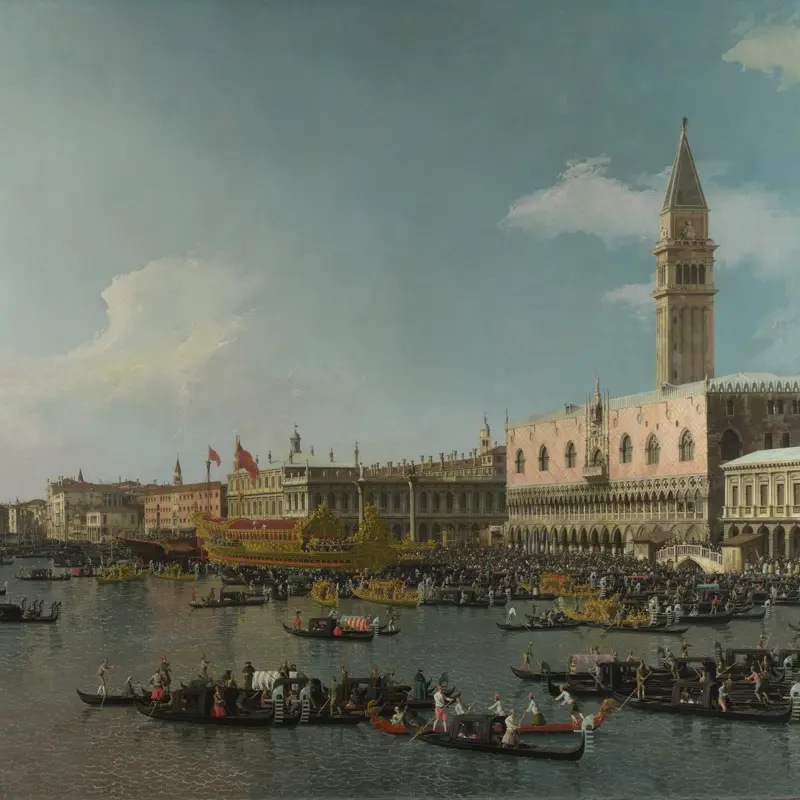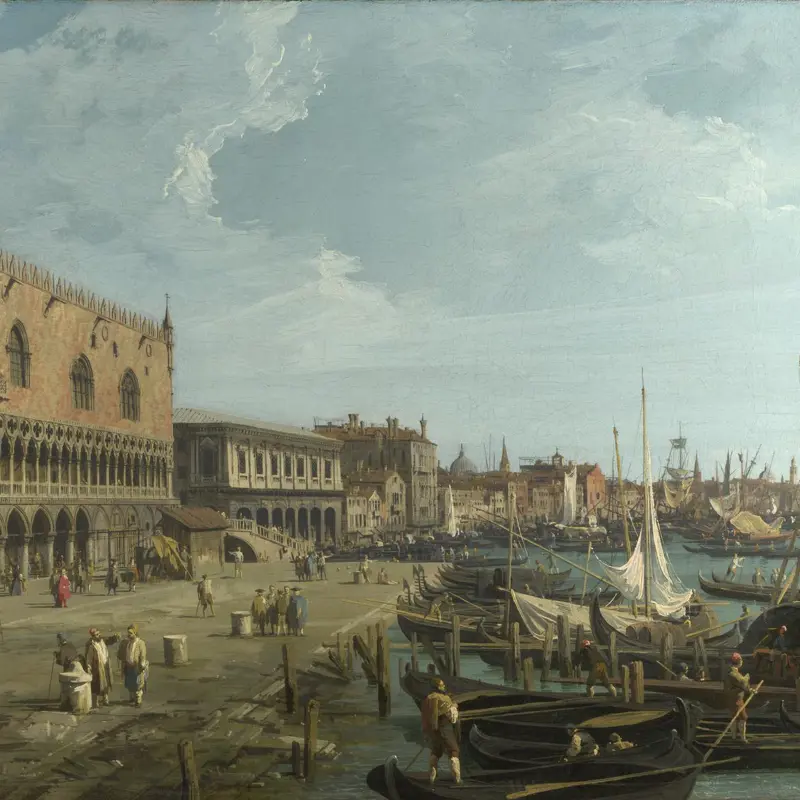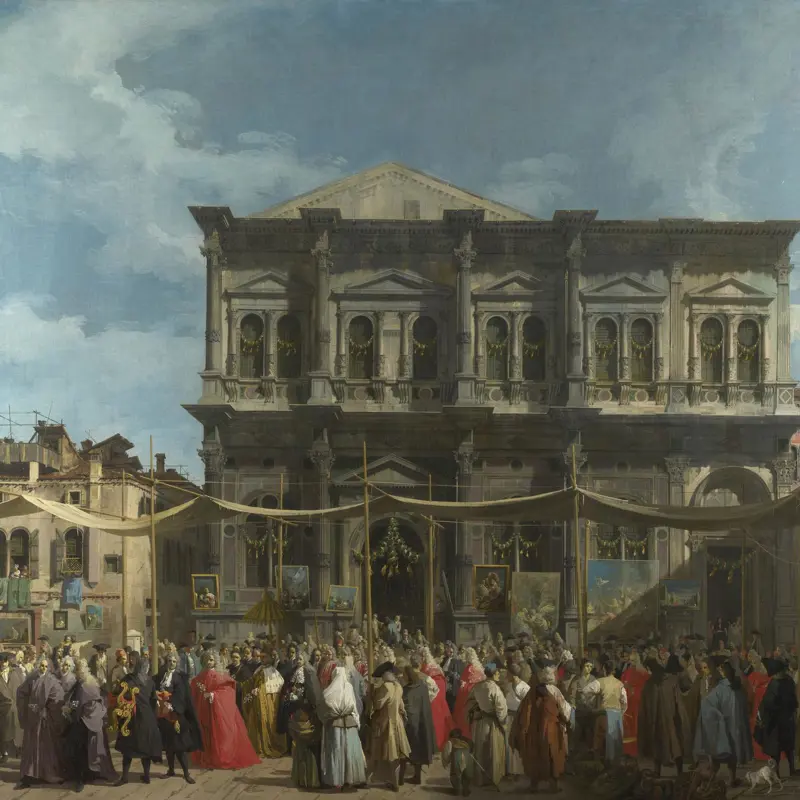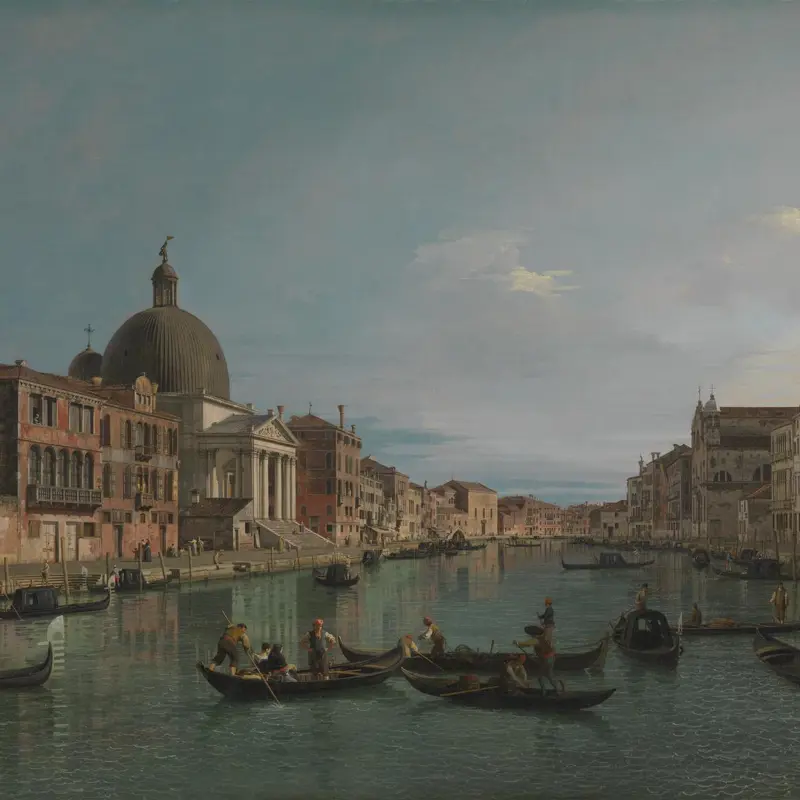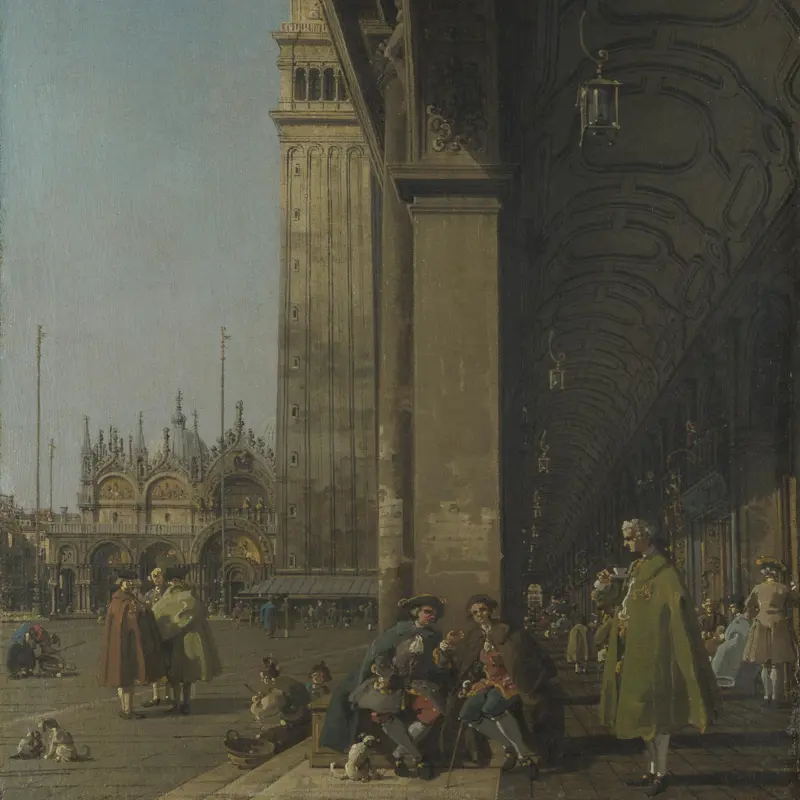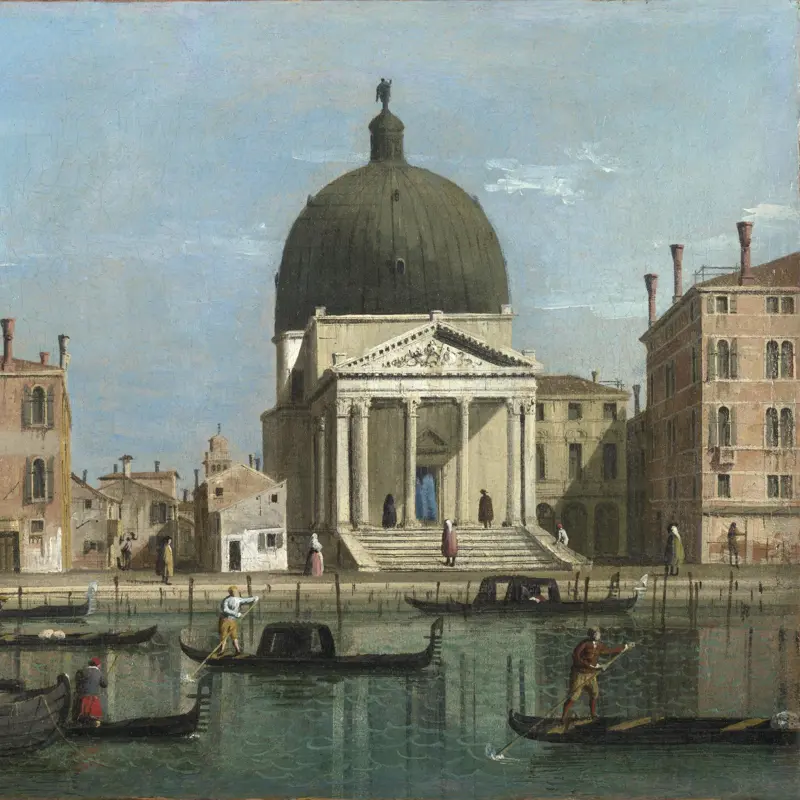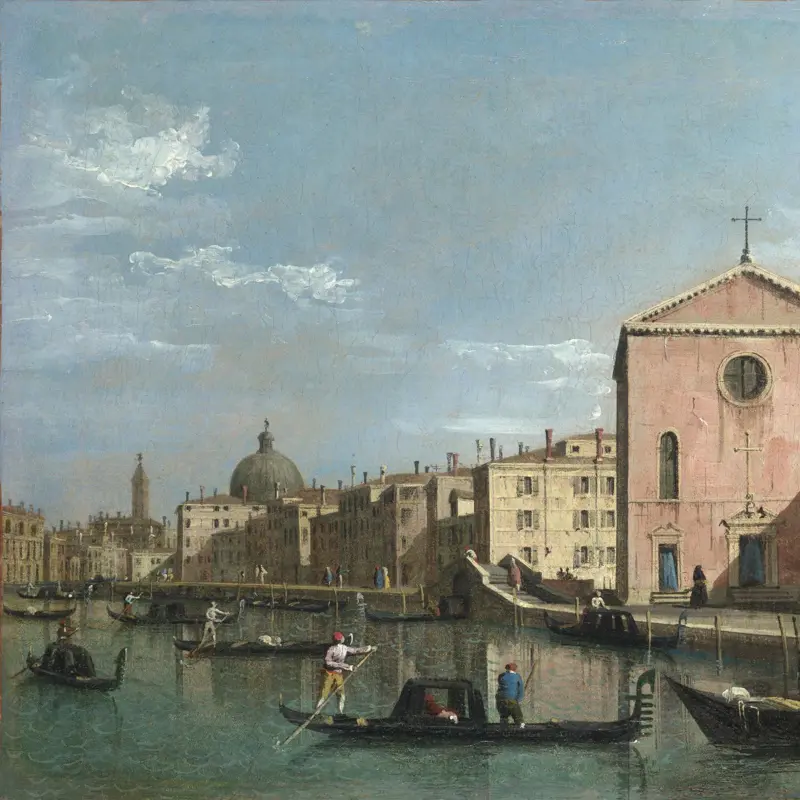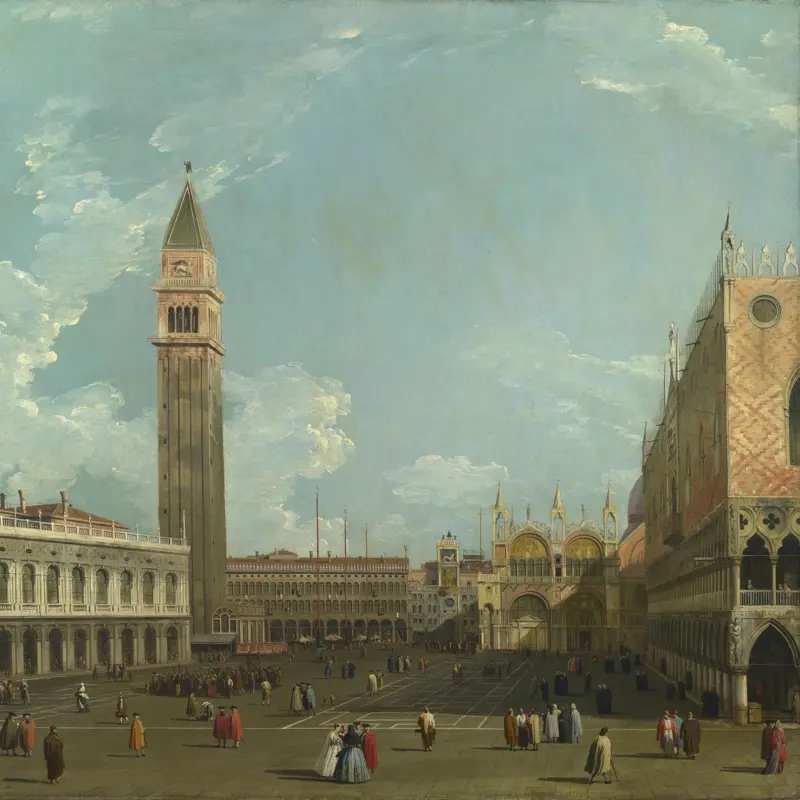Canaletto, 'The Stonemason's Yard', about 1725
About the work
Overview
This intimate view of Venice, weatherbeaten and dilapidated, is one of Canaletto’s masterpieces. In the early morning sun, workmen chisel away at pieces of stone. Everyday life continues around them: a mother rushes to comfort her crying child, watched by a woman on the balcony above.
This square – the Campo San Vidal – was not usually a mason’s yard: it appears to have been temporarily transformed into a workshop while repairs are done to the nearby church of San Vidal. The church of Saint Maria della Carità and its campanile (bell tower) are visible on the far side of the Grand Canal.
Painted during the late 1720s, this is one of Canaletto’s finest early works. He has skilfully described various materials and textures: the crumbling plaster, exposed brick, and rough timber in a subtle range of colours. The buildings of different styles and heights, the animated figures and the areas of light and shadow in this theatrical picture may recall the stage sets Canaletto painted at the very beginning of his career.
Audio description
Listen to an audio description of Canaletto's 'The Stonemason's Yard'
Transcript
This is a description of a detailed oil painting called ‘The Stonemason’s Yard’ by Giovanni Antonio Canal, more commonly known as Canaletto. Painted in about 1725, this is one of Canaletto’s finest early works. It features a view of a back-street city square in Venice, under a vast blue sky. The perspective on the scene is elevated and from a distance - every inch crammed with rich detail. The square is the Camp San Vidal, which has been temporarily turned into a stonemason’s yard. Beyond it the painting depicts the flowing waters of the Grand Canal and the church of Saint Maria della Carita on the far bank. The small figures of stone workers in the square are busy repairing a nearby Church – which is not pictured - and we are given a vivid sense of the everyday lives of the local people around them. The square is enclosed by buildings on the far right and left of the image but it is the activity in the square, and the foreground of the painting, that grabs our attention. This central space is littered with huge chunks of white stone. Two kneeling masons attack them with hammer and chisel. On the right, a temporary wooden shed has been erected for storing equipment or seeking shelter from the midday sun. In front of the dilapidated shed, a woman in a rose-coloured skirt, leans over a well to collect water, her white sleeves rolled up to her elbows. The wellhead is crafted from the same white stone in the yard. Behind the shed is a two-storied, dark-pink dwelling with white
curtains fluttering at open the windows. A woman sits spinning cloth on the wooden balcony. Beyond this are the rooves, chimneys and towers suggesting the densely packed cityscape. To the left of the square part of a three storied dwelling is shown – casting a dark shadow that adds to the paintings sense of depth. It is clad in decaying pink and white plaster and topped with a flaring chimney, typical of Venetian architecture. Its wooden window shutters are flung open and a red breasted cockrel perches on a ground floor window ledge, probably contributing to the general clamour. On the first floor a woman dressed in a brown pinafore and white shirt, her hair up in a bun, leans over a small balcony edged with pot plants. She has one hand on a bundle of drying bedding but is craning to look down at a fallen toddler in the square below. The toddler sprawls on its back in the mud. A slightly older girl stands nearby looking on, but an adult, probably the toddlers Mother, dressed in white blouse and long brown skirt is dashing to the toddler’s aid, an abandoned broom propped up against the building in her wake. Against the side of the dwelling, more figures sit in dense shade, a man and a woman who seem in conversation. Winding its way across the centre of the painting is a narrow strip of the Grand Canal: painted in subdued shades of green. Gondolas are moored along the edge or ferry passengers from bank to bank. The far
bank is lined by buildings and multiple citizens who are dwarfed by the sprawling church of Saint Maria on the left: its tall, pointed bell tower dominating the horizon. Infront of the church is a white painted dwelling and to the right – more houses with rows of washing lines. Above this the top of the painting is filled with pale blue sky, wreathed in skeins of creamy yellow or dark grey cloud. The scene on the far bank is recognisable today although the church and the buildings adjacent are now Venice’s Academia art gallery. Something is missing however: the bell tower collapsed in 1744, a few decades after the painting was made demolishing the house in front of it! As a young artist, Canaletto painted stage scenery for theatres. In this painting, we get a distinct sense of Venice as a theatrical set, populated by its own cast of local players.
Key facts
Details
- Full title
- Venice: Campo S. Vidal and Santa Maria della Carità ('The Stonemason's Yard')
- Artist
- Canaletto
- Artist dates
- 1697 - 1768
- Date made
- About 1725
- Medium and support
- Oil on canvas
- Dimensions
- 123.8 × 162.9 cm
- Acquisition credit
- Sir George Beaumont Gift, 1823; passed to the National Gallery, 1828
- Inventory number
- NG127
- Location
- Room 33
- Collection
- Main Collection
- Previous owners
- Frame
- 20th-century English Frame
Provenance
Additional information
Text extracted from the ‘Provenance’ section of the catalogue entry in Michael Levey, ‘National Gallery Catalogues: The Seventeenth and Eighteenth Century Italian Schools’, London 1986; for further information, see the full catalogue entry.
Exhibition history
-
2010Venice: Canaletto and His RivalsThe National Gallery (London)13 October 2010 - 16 January 2011National Gallery of Art (Washington DC)20 February 2011 - 30 May 2011
-
2018Venice at Vivaldi and Tiepolo's TimeGaleries Nationales du Grand Palais24 September 2018 - 20 January 2019Palazzo Ducale (Venice)23 February 2019 - 9 June 2019
-
2024National TreasuresNational Library of Wales10 May 2024 - 7 September 2024
Bibliography
-
1853National Gallery, Report from the Select Committee on the National Gallery, together with the Proceedings of the Committee, Minutes of Evidence, Appendix, and Index, London 1853
-
1853London, National Gallery Archive, NG15/3: Report from the Select Committee on the National Gallery, together with the Proceedings of the Committee, Minutes of Evidence, Appendix, and Index, 1853
-
1894B. Berenson, The Venetian Painters of the Renaissance, with an Index to Their Works, New York 1894
-
1929G. Fiocco, Venetian Painting of the Seicento and Settecento, Florence 1929
-
1948A. Lhote, Traité du paysage, Paris 1948
-
1949F.J.B. Watson, Canaletto, London 1949
-
1954V. Moschini, Canaletto. Testo di Vittorio Moschini, Milan 1954
-
1955F.J.B. Watson, 'Venetian Paintings at the Royal Academy 1954-5', Arte veneta, 1955
-
1956Levey, Michael, National Gallery Catalogues: The Eighteenth Century Italian Schools, London 1956
-
1967D. Lewis, 'Notes on XVIII Century Venetian Architecture: A Drawing, Some Dates and an Architect Rediscovered (Part 2)', Bollettino dei Musei Civici Veneziani, XII/3, 1967, pp. 17-51
-
1967M. Butor, 'L'Oeil de Michel Butor sur Canaletto', Réalités, 258, 1967, pp. 36-43
-
1971M. Levey, The Seventeenth and Eighteenth Century Italian Schools, London 1971
-
1974A. Corboz, 'Sur la prétendue objectivité de Canaletto', Arte veneta, XXVIII, 1974, pp. 205-18
-
1975L. Puppi, Tout l'oeuvre peint de Canaletto, Paris 1975
-
1976W.G. Constable and J.G. Links, Canaletto: Giovanni Antonio Canal, 1697-1768, revised edn, Oxford 1976
-
1976T. Pignatti, Canaletto, Milan 1976
-
1977J.G. Links, Canaletto and His Patrons, London 1977
-
1978A. Macintyre and K. Garlick (eds), The Diary of Joseph Farington, vol. 5, New Haven 1978-1984
-
1978M. Levey, The Venetian Scene, 2nd edn, London 1978
-
1982J.G. Links, Canaletto, London 1982
-
1982M. Helston, Canaletto: The Stonemason's Yard and Guardi: The Piazza San Marco (exh. cat. The National Gallery, 18 February - 18 April 1982), London 1982
-
1983M. Helston, Spanish and Later Italian Paintings, London 1983
-
1985A. Corboz, Canaletto: Una Venezia immaginaria, Milan 1985
-
1986Levey, Michael, National Gallery Catalogues: The Seventeenth and Eighteenth Century Italian Schools, London 1986
-
1989W.G. Constable and J.G. Links, Canaletto: Giovanni Antonio Canal, 1697-1768, 3rd edn, Oxford 1989
-
1989M. Levey, 'Canaletto as Artist of the Urban Scene', in K. Baetjer and J.G. Links (eds), Canaletto, New York 1989, pp. 17-29
-
1989V. Pemberton-Pigott, 'The Development of Canaletto's Painting Technique', in K. Baetjer and J.G. Links (eds), Canaletto, New York 1989, pp. 53-63
-
1990G. Romanelli, Tra gotico e neogotico: Palazzo Cavalli Franchetti a San Vidal, Venice 1990
-
1990B. Aikema and B. Bakker, Painters of Venice: The Story of the Venetian Veduta, (exh. cat. Rijksmuseum, 15 December 1990 - 10 March 1991), The Hague 1990
-
1993J.H. Whitfield, The Englishness of Canaletto, Birmingham 1993
-
1993D. Bomford and A. Roy, 'Canaletto's "Stonemason's Yard" and "San Simeone Piccolo"', National Gallery Technical Bulletin, XIV, 1993, pp. 34-41
-
1993R. White and J. Pilc, 'Analyses of Paint Media', National Gallery Technical Bulletin, XIV, 1993, pp. 86-94
-
1993D. Succhi and A. Delneri, Marco Ricci e il paesaggio veneto del Settecento (exh. cat. Palazzo Crepadona, 15 May - 22 August 1993), Milan 1993
-
1994J.G. Links, Canaletto, revised edn, London 1994
-
1994J.G. Links, 'Modern Architecture and the View Painters: How the View Painters Viewed the Changes', Apollo, 1994, pp. 7-12
-
1998D. Bomford and G. Finaldi, Venice through Canaletto's Eyes (exh. cat. The National Gallery, 15 July - 11 October 1998; York City Art Gallery, 24 October 1998 - 3 January 1999), London 1998
-
2001
C. Baker and T. Henry, The National Gallery: Complete Illustrated Catalogue, London 2001
About this record
If you know more about this work or have spotted an error, please contact us. Please note that exhibition histories are listed from 2009 onwards. Bibliographies may not be complete; more comprehensive information is available in the National Gallery Library.

